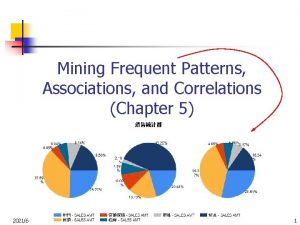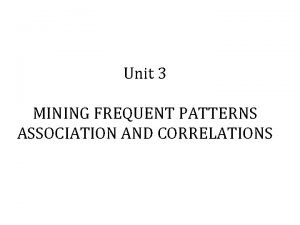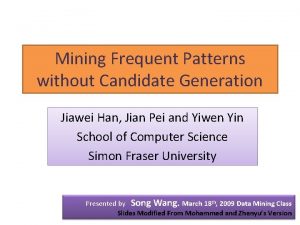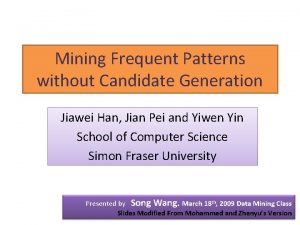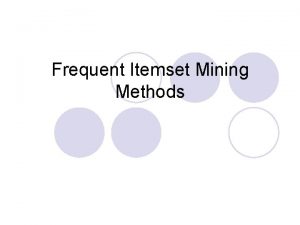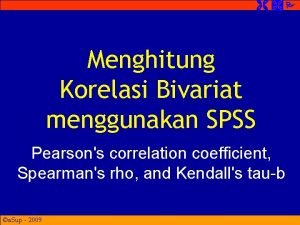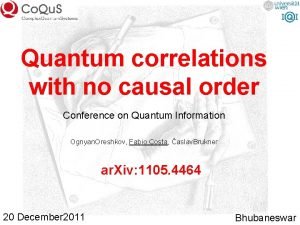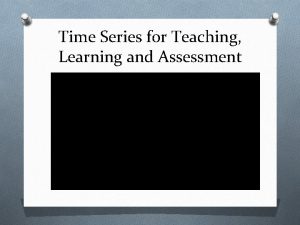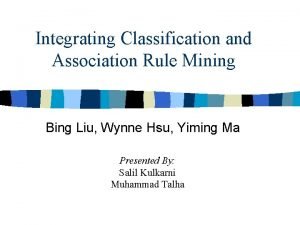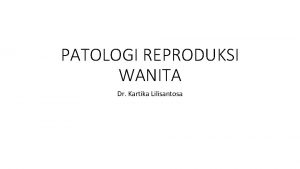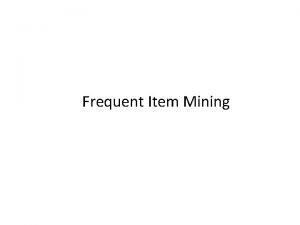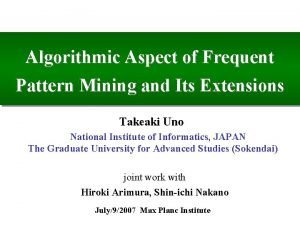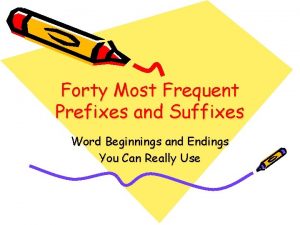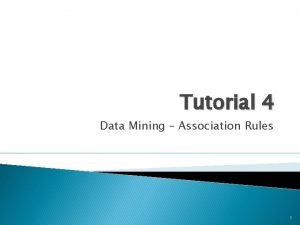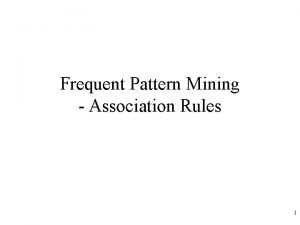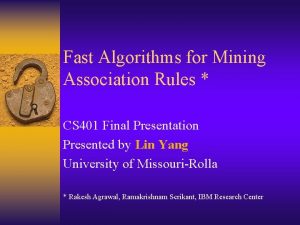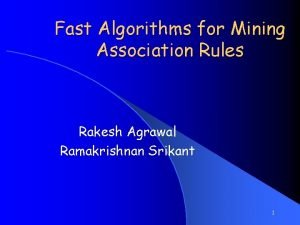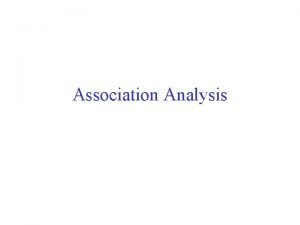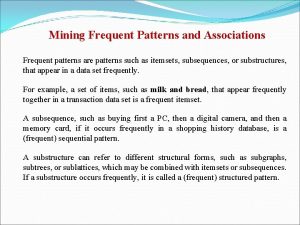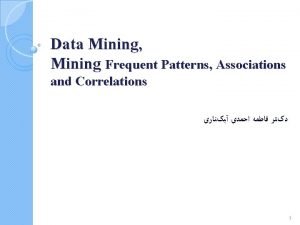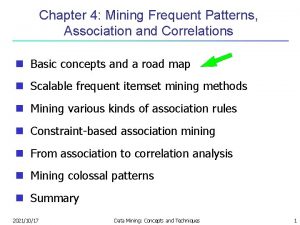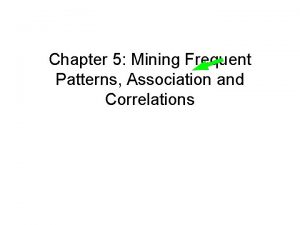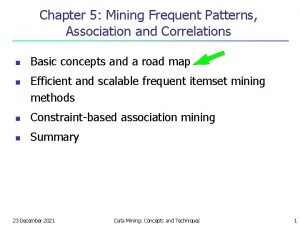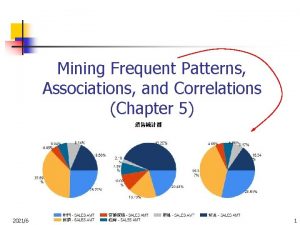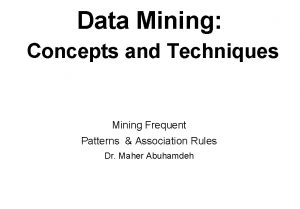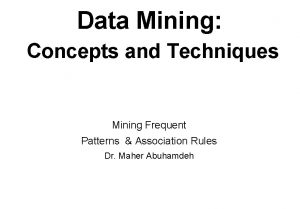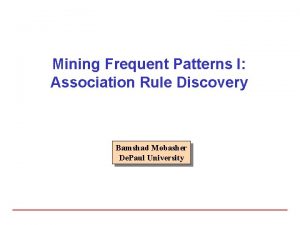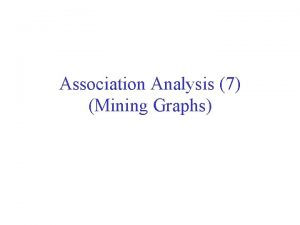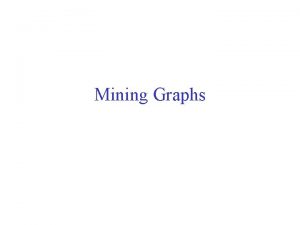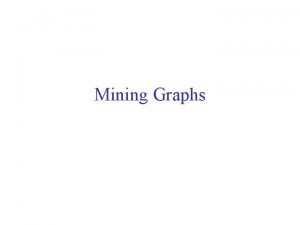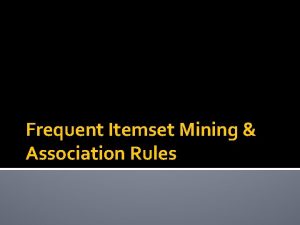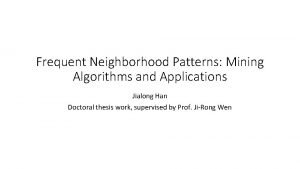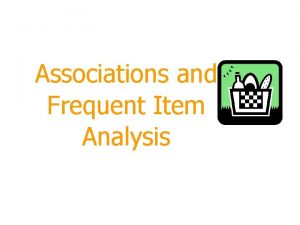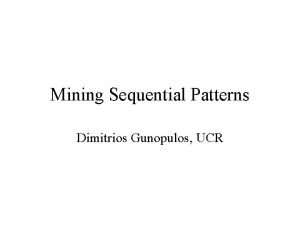Unit 3 MINING FREQUENT PATTERNS ASSOCIATION AND CORRELATIONS

























- Slides: 25

Unit 3 MINING FREQUENT PATTERNS ASSOCIATION AND CORRELATIONS

Introduction • Frequent patterns are patterns (such as itemsets, subsequences, or substructures) that appear in a data set frequently. example, a set of items, such as milk and bread, that appear • frequently together in a transaction data set is a frequent itemset. • A subsequence, such as buying first a PC, then a digital camera, and then a memory card, if it occurs frequently in a shopping history database, is a (frequent) sequential pattern. • A substructure can refer to different structural forms, such as subgraphs, subtrees, or sublattices, which may be combined with itemsets or subsequences. • If a substructure occurs frequently, it is called a (frequent) structured pattern. • Finding such frequent patterns plays an essential role in mining associations, correlations, and many other interesting relationships among data.

Market Basket Analysis: A Motivating Example • Frequent itemset mining leads to the discovery of associations and correlations among items in large transactional or relational data sets. The discovery of interesting correlationships among huge db. help in many business decision-making processes, Customer shopping behavior analysis. example of frequent itemset mining is market basket analysis. It analyzes customer buying habits by finding associations between the different items that customers place in their “shopping baskets” • help retailers develop marketing strategies • • •


Market basket analysis • • • We consider a universe as set of items available at store Each item is boolean variable representing presence/absent of item Each basket is represented as boolean vector These can be represented in form of association rules Association rules are interesting if they satisfy both minimum support and minimum confidence Computer anti virus [support=2%, confidence=50%] Rule support and confidence are two measures of rule interestingness. They reflect the usefulness and certainty of discovered rules. A support of 2% for Association Rule means that 2% of all the transactions under analysis show that computer and antivirus software purchased together. A confidence of 60% means that 60% of the customers who purchased a computer also bought the software. Typically, association rules are considered interesting if they satisfy both a minimum support threshold and a minimum confidence threshold Such thresholds can be set by users or domain experts.

Frequent Itemsets, • Let I =f{I 1, I 2, Im} be a set of items. • Let D, the task-relevant data, be a set of database transactions • each transaction T is a set of items • Each transaction is associated with an identifier, called TID • An association rule is an implication of the form A->B, where A< I , B< I , and A ^ B=Φ • The rule A->B holds in the transaction set D with support s, • s is the percentage of transactions in D that contain A u B (i. e. , the • union of sets A and B • The rule A-> B has confidence c in the transaction set D • c is the percentage of transactions in D containing A that also contain B. This is taken to be the conditional probability, P(B/A).

Frequent Item sets • support(A->B) = P(A U B) • confidence(A)B) = P(B| A) • Rules that satisfy both a minimum support threshold (min sup) and a minimum confidence threshold (min conf) are called strong • An item set that contains k items is a k-itemset. • The set of {computer, antivirus software} is a 2 -itemset. • item set I satisfies a prespecified minimum support threshold and confidence then I is a frequent itemset. • The set of frequent k-itemsets is commonly denoted by Lk • confidence(A->B) = P(B|A) = support(A U B)/support(A) = support count(A U B) /support count(A)

Association rule mining • association rule mining can be viewed as a two-step process: • 1. Find all frequent itemsets: By definition, each of these itemsets will occur at least as frequently as a predetermined minimum support count, min sup. • Generate strong association rules from the frequent itemsets: By definition, these rules must satisfy minimum support and minimum confidence. • itemset is frequent, each of its subsets is frequent as well

Further Improvement of the Apriori Method • Major computational challenges – Multiple scans of transaction database – Huge number of candidates – Tedious workload of support counting for candidates • Improving Apriori: general ideas – Reduce passes of transaction database scans 9

The Apriori Algorithm (Pseudo-Code) Ck: Candidate itemset of size k Lk : frequent itemset of size k L 1 = {frequent items}; for (k = 1; Lk != ; k++) do begin Ck+1 = candidates generated from Lk; for each transaction t in database do increment the count of all candidates in Ck+1 that are contained in t Lk+1 = candidates in Ck+1 with min_support end return k Lk; 10

Improving the Efficiency of Apriori • “How can we further improve the efficiency of Apriori- based mining? ” • Hash-based technique (hashing itemsets into corresponding buckets): • A hash-based technique can be used to reduce the size of the candidate k-itemsets, Ck, for k > 1. • when scanning each transaction in the database to generate the frequent 1 -itemsets, L 1, from the candidate 1 -itemsets in C 1, • we can generate all of the 2 -itemsets for each transaction, hash (i. e. , map) them into the different buckets of a hash table structure, and increase the corresponding bucket counts

Transaction reduction • • • Transaction reduction (reducing the number of transactions scanned in future iterations): A transaction that does not contain any frequent k-itemsets cannot contain any frequent (k+1)-item sets. Therefore, such a transaction can be marked or removed because subsequent scans of the database for j-itemsets, will not require it. Partitioning (partitioning the data to find candidate itemsets): A partitioning technique can be used that requires just two database scans to mine the frequent itemsets It consists of two phases. In Phase I, the algorithm subdivides the transactions of D into n nonoverlapping partitions. If the minimum support threshold for transactions in D is min sup, minimum support count for a partition is min supthe number of transactions in that partition. For each partition, all frequent itemsets within the partition are found.


Improving the Efficiency of Apriori • Sampling (mining on a subset of the given data): The basic idea of the sampling approach is to pick a random sample S of the given data D, and then search for frequent itemsets in S instead of D. • In this way, we trade off some degree of accuracy. • The sample size of S is such that the search for frequent itemsets • in S can be done in main memory • Dynamic itemset counting (adding candidate itemsets at different points during a scan): A dynamic itemset counting technique was proposed in which the database is partitioned into blocks marked by start points. • The technique is dynamic in that it estimates the support of all of the itemsets that have been counted so far, • adding new candidate itemsets if all of their subsets are estimated to be frequent. • The resulting algorithm requires fewer database scans than Apriori.

DIC: Reduce Number of Scans ABCD • ABC ABD ACD BCD AB AC BC AD BD • CD Once both A and D are determined frequent, the counting of AD begins Once all length-2 subsets of BCD are determined frequent, the counting of BCD begins Transactions A B C D Apriori {} Itemset lattice 1 -itemsets 2 -itemsets … 1 -itemsets 2 -items DIC 3 -items 15

Mining Various Kinds of Association Rules • mining multilevel association rules, multidimensional association rules, and • quantitative association rules in transactional and/or relational databases • Mining Multilevel Association Rules • it is difficult to find strong associations among data items • data mining systems should provide capabilities for mining association rules • at multiple levels of abstraction, with sufficient flexibility


Example • The concept hierarchy of Figure 5. 10 has five levels, respectively referred to as levels 0 • to 4, starting with level 0 at the root node for all (the most general abstraction level). • Here, level 1 includes computer, software, printer&camera, and computer accessory, level • 2 includes laptop computer, desktop computer, office software, antivirus software, . . . , and • level 3 includes IBM desktop computer, . . . , Microsoft office software, and so on. Level 4 is • the most specific abstraction level of this hierarchy • Association rules generated from mining data at multiple levels of abstraction are • called multiple-level or multilevel association rules

• top-down strategy is employed, where counts are accumulated for the • calculation of frequent itemsets at each concept level, starting at the concept level • 1 and working downward in the hierarchy toward the more specific concept levels, • until no more frequent itemsets can be found. For each level, any algorithm for • discovering frequent itemsets may be used

• Using uniform minimum support for all levels (referred to as uniform support): • The same minimum support threshold is used when mining at each level of • abstraction. For example, in Figure 5. 11, a minimum support threshold of 5% is • used throughout • search procedure is • simplified. The method is also simple in that users are required to specify only one • minimumsupport threshold


• uniform support approach, however, has some difficulties. It is unlikely that • items at lower levels of abstraction will occur as frequently as those at higher levels • of abstraction. If the minimum support threshold is set too high, it could miss some • meaningful associations occurring at low abstraction levels. If the threshold is set too • low, it may generate many uninteresting associations occurring at high abstraction • levels.

reduced support • Using reduced minimum support at lower levels (referred to as reduced support): • Each level of abstraction has its own minimum support threshold. The deeper • the level of abstraction, the smaller the corresponding threshold is. For example, • in Figure 5. 12, the minimum support thresholds for levels 1 and 2 are 5% and 3%, • respectively.

Using itemor group-based minimum support • Using itemor group-based minimum support (referred to as groupbased support): • Because users or experts often have insight as to which groups are more important • than others, it is sometimes more desirable to set up user-specific, item, or groupbased • minimal support thresholds when miningmultilevel rules. For example, a user • could set up the minimum support thresholds based on product price, or on items of • interest, • Apriori property may not always hold uniformly across all of the items • when mining under reduced support and group-based support

Mining Multidimensional Association Rules from Relational Databases and • association Data. Warehouses rules that imply a single predicate, • that is, the predicate buys. For instance, in mining our All. Electronics database, we may • discover the Boolean association rule • buys(X, “digital camera”))buys(X, “HP printer”). a singledimensional • or intradimensional association rule because it contains a single distinct • predicate (e. g. , buys)withmultiple occurrences
 Mining frequent patterns associations and correlations
Mining frequent patterns associations and correlations Eclat algorithm
Eclat algorithm Mining frequent patterns associations and correlations
Mining frequent patterns associations and correlations Dbminer
Dbminer Mining frequent patterns without candidate generation
Mining frequent patterns without candidate generation Apriori algorithm
Apriori algorithm Analisis korelasi bivariat
Analisis korelasi bivariat Quantum correlations with no causal order
Quantum correlations with no causal order Spurious correlations
Spurious correlations Illusory correlations ______.
Illusory correlations ______. Difference between strip mining and open pit mining
Difference between strip mining and open pit mining Text and web mining
Text and web mining Strip mining vs open pit mining
Strip mining vs open pit mining Strip mining vs open pit mining
Strip mining vs open pit mining Mining multimedia databases
Mining multimedia databases Mining complex types of data in data mining
Mining complex types of data in data mining Integrating classification and association rule mining
Integrating classification and association rule mining Excessive frequent and irregular menstruation artinya
Excessive frequent and irregular menstruation artinya Frequent pattern
Frequent pattern Maximal and closed frequent itemsets
Maximal and closed frequent itemsets Most common prefixes suffixes and root words
Most common prefixes suffixes and root words Association rule mining tutorial
Association rule mining tutorial Frequent pattern
Frequent pattern Fast algorithms for mining association rules
Fast algorithms for mining association rules Fast algorithms for mining association rules
Fast algorithms for mining association rules Association
Association
